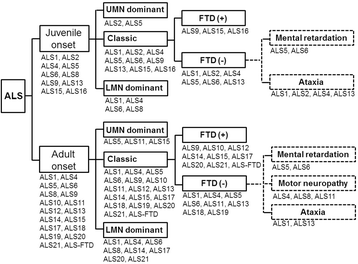Genotype-phenotype correlations of amyotrophic lateral sclerosis
- PMID: 26843957
- PMCID: PMC4738789
- DOI: 10.1186/s40035-016-0050-8
Genotype-phenotype correlations of amyotrophic lateral sclerosis
Abstract
Amyotrophic lateral sclerosis (ALS) is a devastating neurodegenerative disease characterized by progressive neuronal loss and degeneration of upper motor neuron (UMN) and lower motor neuron (LMN). The clinical presentations of ALS are heterogeneous and there is no single test or procedure to establish the diagnosis of ALS. Most cases are diagnosed based on symptoms, physical signs, progression, EMG, and tests to exclude the overlapping conditions. Familial ALS represents about 5 ~ 10 % of ALS cases, whereas the vast majority of patients are sporadic. To date, more than 20 causative genes have been identified in hereditary ALS. Detecting the pathogenic mutations or risk variants for each ALS individual is challenging. However, ALS patients carrying some specific mutations or variant may exhibit subtly distinct clinical features. Unraveling the respective genotype-phenotype correlation has important implications for the genetic explanations. In this review, we will delineate the clinical features of ALS, outline the major ALS-related genes, and summarize the possible genotype-phenotype correlations of ALS.
Keywords: Amyotrophic lateral sclerosis; Causative genes; Diagnosis of ALS; Genetic explanations; Genotype-phenotype correlations.
Figures
Similar articles
-
Genotype-phenotype relationship in hereditary amyotrophic lateral sclerosis.Transl Neurodegener. 2015 Jul 24;4:13. doi: 10.1186/s40035-015-0036-y. eCollection 2015. Transl Neurodegener. 2015. PMID: 26213621 Free PMC article.
-
Natural history of young-adult amyotrophic lateral sclerosis.Neurology. 2008 Sep 16;71(12):876-81. doi: 10.1212/01.wnl.0000312378.94737.45. Epub 2008 Jul 2. Neurology. 2008. PMID: 18596241
-
Lower motor neuron involvement in TAR DNA-binding protein of 43 kDa-related frontotemporal lobar degeneration and amyotrophic lateral sclerosis.JAMA Neurol. 2014 Feb;71(2):172-9. doi: 10.1001/jamaneurol.2013.5489. JAMA Neurol. 2014. PMID: 24378564
-
Clinical and genetic heterogeneity of amyotrophic lateral sclerosis.Clin Genet. 2013 May;83(5):408-16. doi: 10.1111/cge.12117. Epub 2013 Mar 12. Clin Genet. 2013. PMID: 23379621 Review.
-
Extra-motor abnormalities in amyotrophic lateral sclerosis: another layer of heterogeneity.Expert Rev Neurother. 2017 Jun;17(6):561-577. doi: 10.1080/14737175.2017.1273772. Epub 2017 Jan 3. Expert Rev Neurother. 2017. PMID: 27983884 Review.
Cited by
-
Transcriptional profiling of HERV-K(HML-2) in amyotrophic lateral sclerosis and potential implications for expression of HML-2 proteins.Mol Neurodegener. 2018 Aug 2;13(1):39. doi: 10.1186/s13024-018-0275-3. Mol Neurodegener. 2018. PMID: 30068350 Free PMC article.
-
Epidemiological, Clinical and Genetic Features of ALS in the Last Decade: A Prospective Population-Based Study in the Emilia Romagna Region of Italy.Biomedicines. 2022 Mar 31;10(4):819. doi: 10.3390/biomedicines10040819. Biomedicines. 2022. PMID: 35453569 Free PMC article.
-
Advances in the discovery of genetic risk factors for complex forms of neurodegenerative disorders: contemporary approaches, success, challenges and prospects.J Genet. 2018 Jul;97(3):625-648. J Genet. 2018. PMID: 30027900 Review.
-
The landscape of cognitive impairment in superoxide dismutase 1-amyotrophic lateral sclerosis.Neural Regen Res. 2023 Jul;18(7):1427-1433. doi: 10.4103/1673-5374.361535. Neural Regen Res. 2023. PMID: 36571338 Free PMC article. Review.
-
Design of a Randomized, Placebo-Controlled, Phase 3 Trial of Tofersen Initiated in Clinically Presymptomatic SOD1 Variant Carriers: the ATLAS Study.Neurotherapeutics. 2022 Jul;19(4):1248-1258. doi: 10.1007/s13311-022-01237-4. Epub 2022 May 18. Neurotherapeutics. 2022. PMID: 35585374 Free PMC article. Clinical Trial.
References
-
- Sathasivam S. Motor neurone disease: clinical features, diagnosis, diagnostic pitfalls and prognostic markers. Singapore Med J. 2010;51:367–372. - PubMed
Publication types
LinkOut - more resources
Full Text Sources
Other Literature Sources
Research Materials
Miscellaneous


